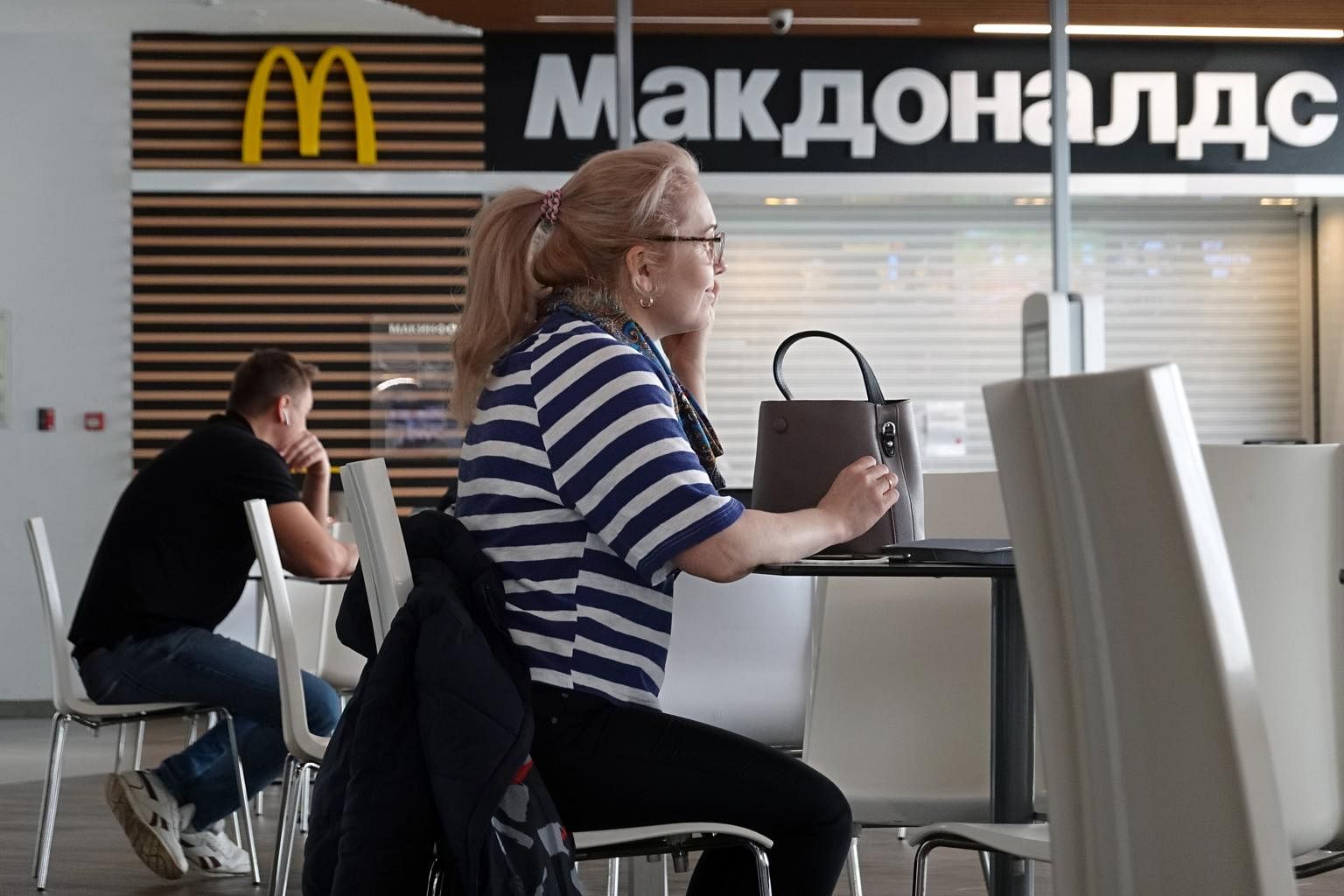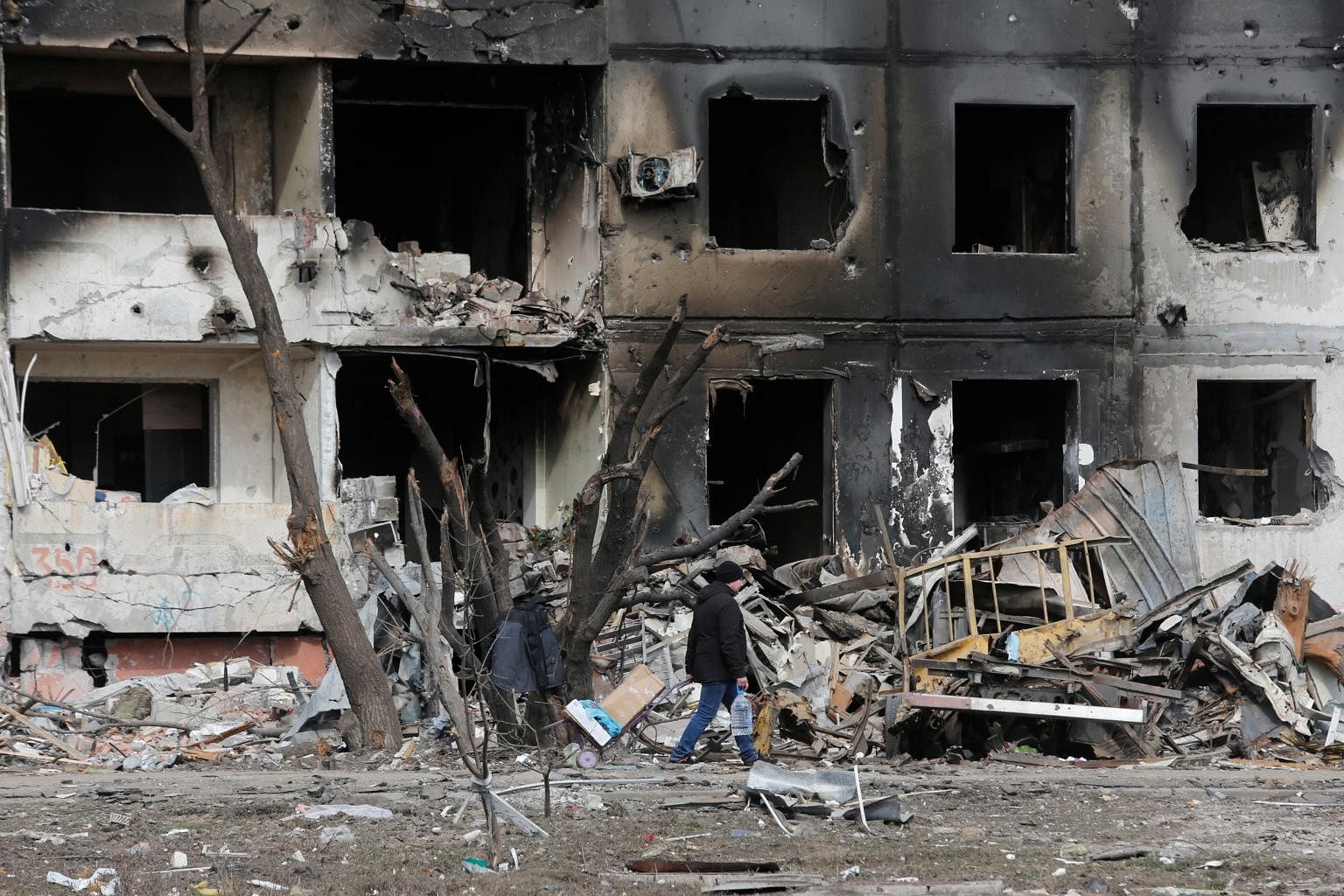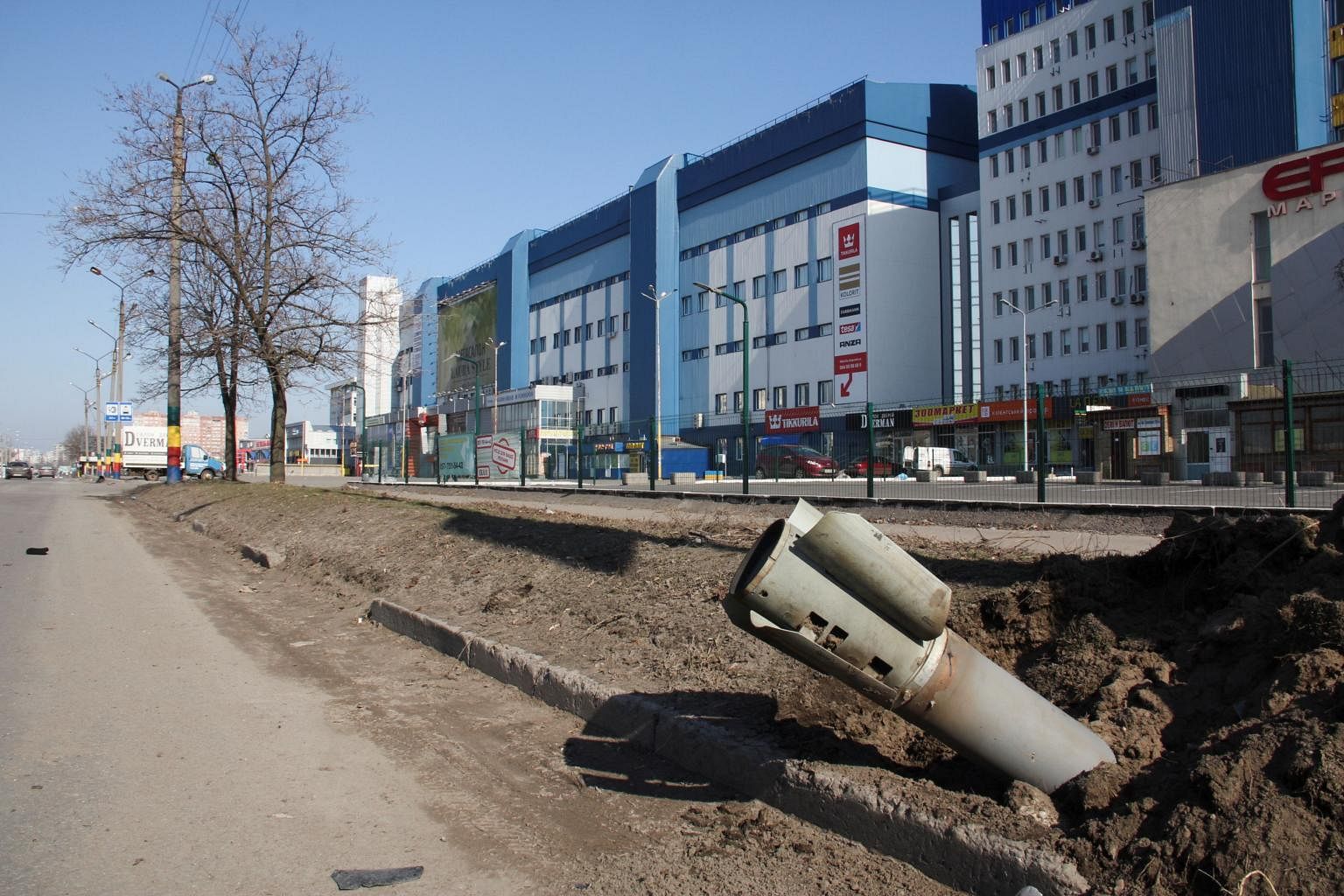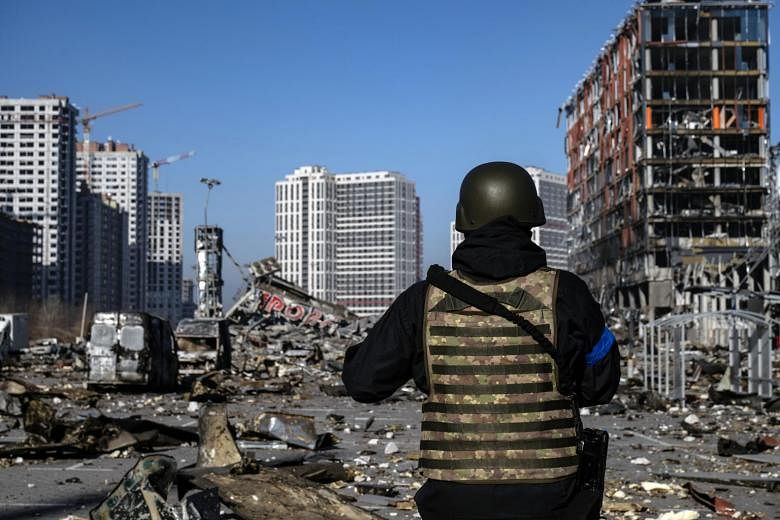NEW YORK (NYTIMES) One month after President Vladimir Putin ordered his military forces to invade Ukraine, Russia has triggered a humanitarian catastrophe unseen in Europe since the end of World War II while achieving almost none of its military objectives.
Ukraine's major cities remain under government control, including the capital, Kyiv.
Moscow had hoped to quickly topple the government of President Volodymyr Zelenskyy, which Putin said was controlled by "Nazis", but the Ukrainian leader has not only survived but continues to inspire resistance at home.
But the toll on civilians grows by the hour. Half the nation's 7.5 million children have been forced from their homes.
Millions more civilians are stranded in cities and towns being bombarded daily by Russian forces.
Across eastern and southern Ukraine, peaceful villages are in ruins, Russian forces have destroyed critical infrastructure, leaving vast swaths of the country without power, heat and water.
Hundreds of thousands of Ukrainians now sleep in basements, subway stations and bomb shelters hoping they will be alive to see the dawn.
The war is far from over and military analysts suggest it could turn into a gruelling war of attrition, where Russia will have the advantage of vastly superior weapons and an army that is many times larger than that of its smaller neighbour.
Here is a look back at the first month of the war:
Week One: Feb 24 to March 3
Explosions began thundering across Ukraine before 5am on Feb 24, minutes after Mr Putin declared the start of a "special military operation" to "demilitarise" Ukraine.
Russian troops attacked from Belarus, pushing south through the highly radioactive Chernobyl exclusion zone, as they advanced toward Kyiv.
In the south, Russian tanks and soldiers blazed out of staging positions in Crimea, which Russia annexed in 2014.
Those forces were joined by naval infantry who came ashore in amphibious assaults, and Russia moved quickly to secure territory along the coasts of the Black Sea and Sea of Azov.
Kherson became the first major Ukrainian city to fall. Russian troops also gained ground to the east as they moved on Mariupol. There were fears that the vital southern port city could soon be encircled by Russian forces.
In the east, the Russian military used the breakaway regions of Donetsk and Luhansk, controlled by Russian-backed forces, as a springboard to launch devastating assaults, including against Ukraine's second largest city, Kharkiv.
In just seven days, 1 million people fled the country, according to the United Nations. Millions more sought safety in the western reaches of Ukraine.
A vast network of Ukrainian volunteers emerged to help those stranded in the cities under assault.
Martial law was declared, forbidding men between the ages of 18 and 60 from leaving the country, and tens of thousands of Ukrainians picked up weapons for the first time as they joined territorial defence units.
Alcohol was banned and restaurants around the country emptied their glass bottles so they could be used for Molotov cocktails.
President Joe Biden warned in a defiant State of the Union address that Putin "has no idea what's coming".
Western allies, moving swiftly and largely in unison, imposed a sweeping package of sanctions that left the Russian economy reeling.
Russian artillery and rocket fire was increasingly aimed at civilian infrastructure, cutting off essentials like electricity, medicine, water and heat. In Kyiv alone, 15,000 people started sleeping in the subways.
"We've hardly slept for seven nights," Mr Zelenskyy said after one week of war. But he added, "Today you, Ukrainians, are a symbol of invincibility."
Week Two: March 3-10

As Russia continued to bombard cities across Ukraine, the war began to exact an increasing toll beyond the battlefield and inside Russia itself.
Mr Biden banned Russian oil imports, roiling energy markets. Businesses, including McDonald's and Coca-Cola, closed operations in Russia, quickly turning the country into an international pariah.
Still, top US intelligence officials told Congress that Mr Putin showed no signs of changing course. Faced with military setbacks and a determined Ukrainian resistance, Russia stepped up its attacks on civilians.
Kyiv, a modern European metropolis, was rapidly transformed into a fortress city. The barricades in the southern port city of Odesa were raised. And the western city of Lviv prepared for a long struggle.
In Mariupol, now encircled by Russian forces, hundreds of thousands of people remained trapped without water, electricity and other basic services. The bombing of a maternity ward in the city became a global symbol of the savage war.
The UN reported that more than 2 million Ukrainians - half of them children - had fled the country.
But as Russian forces suffered heavy losses, it was becoming clear that the Kremlin's military planners, not to mention Mr Putin himself, had dramatically miscalculated, not only about the grit of Ukrainian resistance but also the calamitous economic consequences for Russia.
Mr Zelenskyy vowed to never give in to Russia's tanks, troops or artillery shells.
"We will fight till the end, at sea, in the air," Mr Zelenskyy said in a video address to Britain's Parliament.
"We will fight in the forests, in the fields, on the shores, in the streets."
Week Three: March 10-17

Russian forces, battered by a determined Ukrainian resistance, stepped up their aerial bombardment across Ukraine, targeting locations far from the front lines while continuing to pummel cities already devastated by fighting.
The renewed Russian push came as the war took a decidedly darker turn, with hundreds of thousands of people now living in primeval conditions in besieged cities as Russian forces tried to batter the country into submission.
The situation was catastrophic in Mariupol, where the number of dead grew daily.
Bodies were buried in trenches and backyards.
A theatre believed to shelter as many as 1,300 people was destroyed by a Russian missile despite being clearly marked as a refuge for children.
It is not known how many people died in that one attack and there was no reliable estimate for the number killed in the city.
Other cities under assault by Russian troops reported increasingly barbaric attacks. Dozens of schools, hospitals and residential buildings across the country were destroyed, according to international observers including the United Nations.
Vicious fighting in the cities around Kyiv inflicted heavy losses on both armies.
With Russia's forces struggling on the battlefield, Mr Putin called pro-Western Russians "scum and traitors" who needed to be removed from society.
He described the war in Ukraine as part of an existential clash with the US and set the stage for an ever fiercer crackdown on dissent at home and even more aggression abroad.
Week Four: March 17-24

As the first month of the war drew to a close, with Russian forces still unable to seize major cities, there was an emerging consensus in the West that the conflict had reached a bloody stalemate.
Russia continued to make some gains in the eastern part of the country and it continued to hold territory in the south around Kherson.
But with its ground forces meeting stiff Ukrainian resistance, Russia increasingly turned to long-range missiles to target Ukrainian military and civilian infrastructure.
In a war of attrition, military analysts said, Russia sought to break down the Ukrainian military while crushing the public's spirit with relentless assaults.
Firing rockets and bombs from the land, the air and from warships in the Sea of Azov, Russian forces broadened their bombardment of the besieged Ukrainian city of Mariupol.
Its soldiers forcibly deported thousands of residents, according to city officials and witnesses.
An art school, where about 400 residents were hiding, was destroyed. The number of casualties was not known. Across Ukraine, half of the nation's children had been forced to flee their homes.
Ukrainian forces mounted ever more aggressive counter offensives on multiple fronts, including around Kyiv, where the more heavily armed Russians were still unable to gain a decisive advantage.
The Russians continued to suffer heavy losses.
The Pentagon estimated that in three weeks of fighting, 7,000 Russian soldiers had been killed - greater than the number of US troops killed over 20 years in Iraq and Afghanistan.
There was rising concern among Western leaders that Mr Putin might turn to unconventional weapons in an attempt to regain momentum, an issue hanging over a summit and meetings held between Biden and allied nations Thursday.
Before the meetings, Mr Zelenskyy renewed his calls for the West to supply his country with weapons to fight the Russians.
"Life can be defended only when united," he said. "Freedom must be armed."

